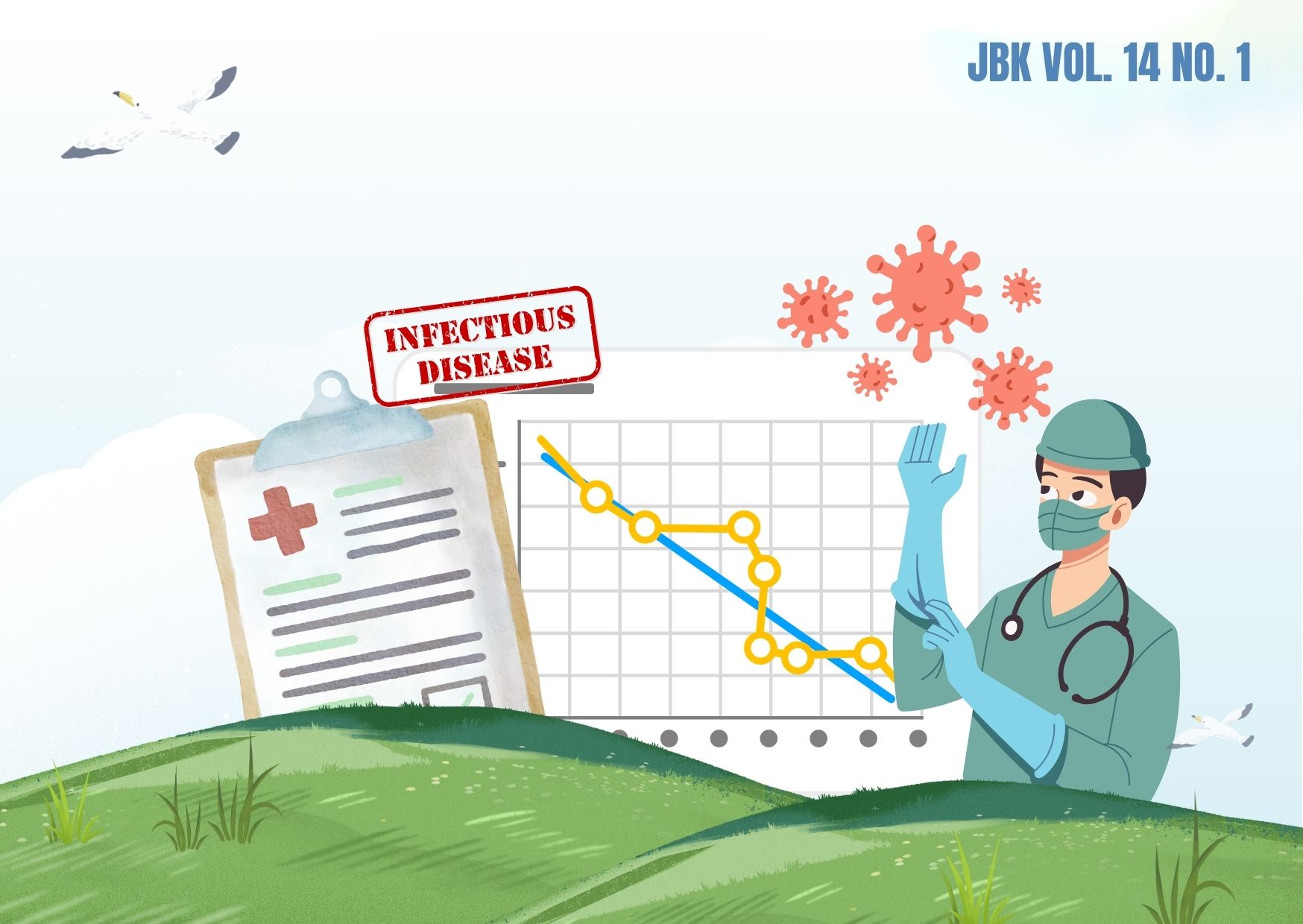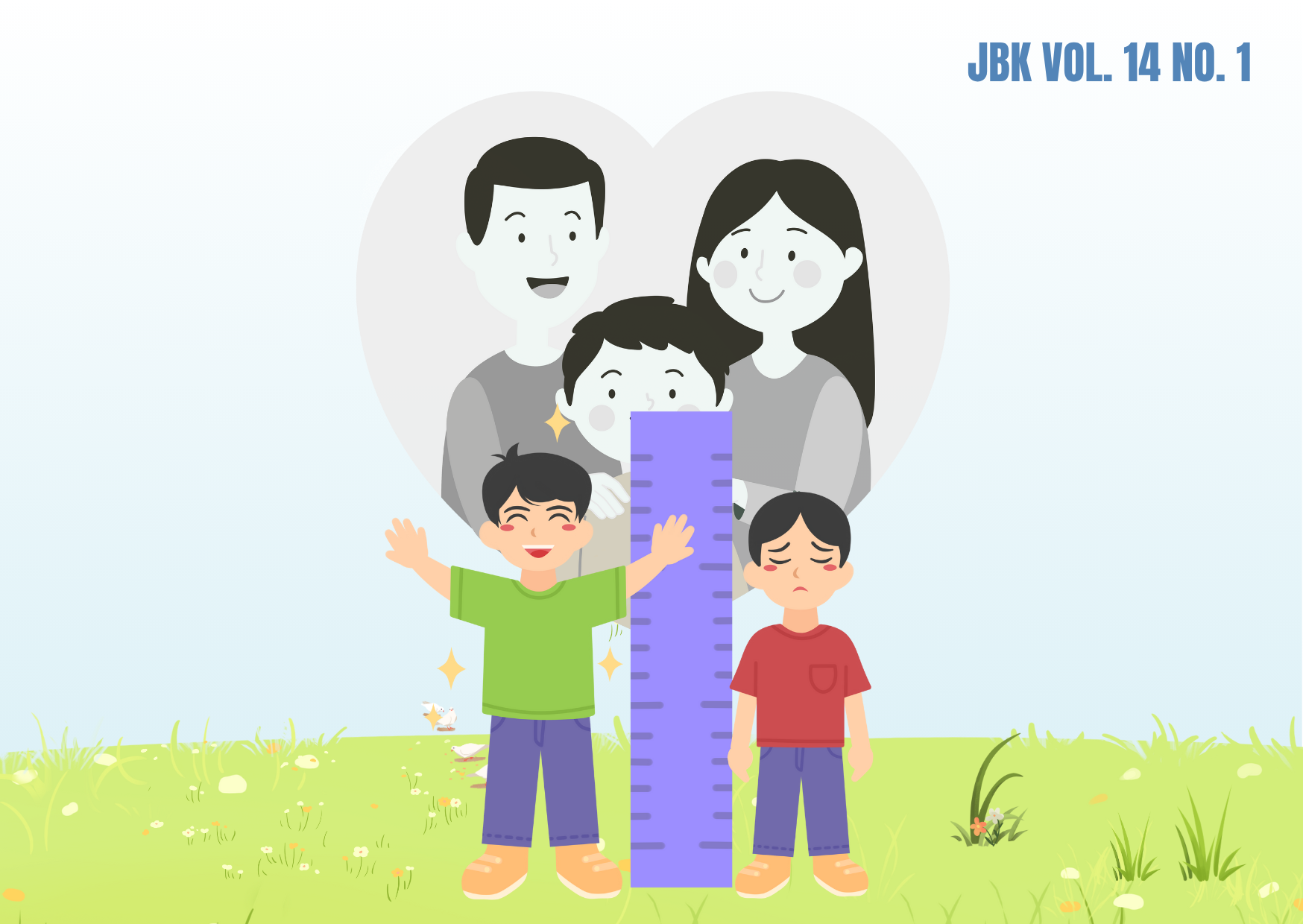DETERMINANTS DROP OUT EVENTS TOOLS WOMEN CONTRACEPTIVE FERTILE AGE 15-49 YEARS IN THE BENGKULU PROVINCE (2017 IDHS DATA ANALYSIS)

Downloads
The continued use of contraception has an effect on the effectiveness of a contraceptive method to prevent the occurrence of an unwanted pregnancy. The purpose of this study is to find the association of the incidence of contraceptive discontinuation in women of 15-49 years of age in Bengkulu Province. While the benefits of this study specifically for the National Population and Family Planning Board (BKKBN) are to overcome the problems associated with Population, Family Planning and Family Development (KKBPK) for the discontinuation of contraceptive use in WUS in Family Planning in Bengkulu Province. This study uses a cross-sectional design using secondary data from the 2017 IDHS data on respondents of Fertile Age Women, and the results of the data analyzed using the SPSS program with the Univariate, Bivariate Chi-Square test. The results of this study found that WUS who discontinued using contraceptives were 89 people (33.8%), with the reason that the dominant husband opposed 85 people (32.3%) and health problems as many as 44 people (16.7%). Most were 15-35 years old and high school graduates, most worked and lived in the village. There is no relationship between age (p value 0.420), education (p value 0.304), employment (p value 0.275), area of residence (p value 0.714) and wealth index (economy) (p value 0.232) with the incidence of contraceptive use in Fertile Age Women Bengkulu Province. Factors of age, education, occupation, area of residence and wealth index (economy) impact the incidence of dropping out of contraceptive use in women of childbearing age.
Aryati S, Sukamdi S, Widyastuti D. Faktor-Faktor yang Mempengaruhi Pemilihan Metode Kontrasepsi (Kasus di Kecamatan Seberang Ulu I Kota Palembang). Maj Geogr Indones. 2019;33(1):79–85. doi: https://doi.org/10.22146/mgi.35474
Hastuty M, Afiah. Faktor-faktor yang Mempengaruhi Perilaku Akseptor KB terhadap Pemilihan MKJP di Wilayah Kerja Puskesmas Tambang Tahun 2018. J Doppler Univ Pahlawan Tuanku Tambusai. 2018;2(2):1–12. Available from: https://journal.universitaspahlawan.ac.id/index.php/doppler/article/view/192
Amru DE. Hubungan Tingkat Pengetahuan, Sikap dan Keterjangkauan Jarak Pelayanan Kesehatan terhadap Kejadian Drop Out Alat Kontrasepsi Suntik pada Pasangan Usia Subur (PUS) di Wilayah Kerja Puskesmas Sekupang Kota Batam. J Bidan Komunitas. 2019;2(2):117–25. doi: https://doi.org/10.33085/jbk.v2i2.4341
Badan Pusat Statistik, Badan Kependudukan dan Keluarga Berencana Nasional, Kementerian Kesehatan, USAID. Survei Demografi Kesehatan Indonesia. BKKBN. 2017;1–606. Available from: https://www.bps.go.id/statictable/2020/10/21/2111/laporan-survei-demografi-dan-kesehatan-indonesia.html
Nuryati S. Hubungan Antara Kualitas Pelayanan KB oleh Bidan dengan Pemilihan Metode Kontrasepsi Jangka Panjang ( MKJP ) pada Akseptor KB Baru di Kabupaten Bogor. J Ilm Kesehat Diagnosis. 2016;8(1):73–81. Available from: http://ejournal.stikesnh.ac.id/index.php/jikd/article/view/220
Huda AN, Widagdo L, Widjanarko B, Pendidikan B, Ilmu K, Masyarakat FK, et al. Faktor-Faktor yang Berhubungan dengan Perilaku Penggunaan Alat Kontrasepsi pada Wanita Usia Subur di Puskesmas Jombang-Kota Tangerang Selatan. J Kesehat Masy. 2016;4(1):461–9. Available from: https://ejournal3.undip.ac.id/index.php/jkm/article/view/11856
Indrawati L. Determinan Kejadian Berhenti Pakai (Drop Out) Kontrasepsi di Indonesia (Analisa Sekunder Data RISKESDAS 2010). Bul Penelit Sist Kesehat. 2014;17(1):55–62. Available from: https://adoc.pub/determinan-kejadian-berhenti-pakai-drop-out-kontrasepsi-di-i.html
Amran Y, Damayanti R. Hubungan Antara Motivasi Keluarga Berencana dan Persepsi Terhadap Alat Kontrasepsi dengan Pola Penggantian Metode Kontrasepsi di Nusa Tenggara Barat. 2018;9(1):59–67. Available from: https://ejournal2.litbang.kemkes.go.id/index.php/kespro/article/view/884
Qonitun U. Hubungan Antara Efek Samping Kontrasepsi DMPA dengan Kejadian Drop Out pada Pasangan Usia Subur (PUS) di Desa Mandirejo Kecamatan Merakurak Kabupaten Tuban. J Midpro. 2017;9(2):30–4. doi: https://doi.org/10.30736/midpro.v9i2.23
Majid M. Pengembangan Metode Penyuluhan Meningkatkan Pemakaian Alat Kontrasepsi. Media Kesehat Masy Indones. 2017;13(1):91–6. Available from: https://journal.unhas.ac.id/index.php/mkmi/article/view/1585
Adriani L, Hastono SP. Determinan Partisipasi Penggunaan Kontrasepsi Modern pada Pria Kawin Usia 15-54 Tahun di Indonesia (Analisis Data Survei Demografi dan Kesehatan Indonesia 2012). Forum Ilm. 2016;13(2):76–93. Available from: https://ejurnal.esaunggul.ac.id/index.php/Formil/article/view/1397
Nurjannah SN, Susanti E. Determinan Kejadian Drop Out Penggunaan Kontrasepsi pada Pasangan Usia Subur (PUS) di Kabupaten Kuningan. J Ilmu Kesehat Bhakti Husada. 2017;6(2):1–10. Available from: https://ejournal.stikku.ac.id/index.php/stikku/article/view/45
Aini AN, Mawarni A, Dharminto D. Faktor-Faktor yang Berhubungan dengan Kejadian Drop Out Akseptor KB di Kecamatan Tembalang Kota Semarang. J Kesehat Masy. 2016;4(4):169–76. Available from: https://ejournal3.undip.ac.id/index.php/jkm/article/view/13985
Pratiwi ED, Sariyati S. Agama dengan Keikutsertaan Keluarga Berencana ( KB ) dan Pemilihan Jenis Alat Kontrasepsi pada Pasangan Usia Subur ( PUS ) di Desa Argomulyo Sedayu Bantul Yogyakarta. J Ners dan Kebidanan Indones. 2015;3(1):1–9. doi: http://dx.doi.org/10.21927/jnki.2015.3(1).1-9
Warmin AE, Multazam A, Arman. Penggunaan Kontrasepsi pada Wanita Menikah Usia Dini di Kec. Gantarang Kab. Bulukumba. J Ilm Kesehat Diagnosis. 2017;11(3):274–8. Available from: http://ejournal.stikesnh.ac.id/index.php/jikd/article/view/770
Mehra D, Sarkar A, Sreenath P, Behera J, Mehra S. Effectiveness of A Community Based Intervention to Delay Early Marriage , Early Pregnancy and Improve School Retention Among Adolescents in India. BMC Public Health. 2018;18:1–13. doi: https://doi.org/10.1186/s12889-018-5586-3
Septalia R, Puspitasari N. Faktor yang Memengaruhi Pemilihan Metode Kontrasepsi. J Biometrika dan Kependud. 2016;5(2):91–8. doi: http://dx.doi.org/10.20473/jbk.v5i2.2016.91-98
Saleh S, Ashriady A, Akbar F. Analisis faktor yang Berhubungan dengan Kejadian Efek Samping pada Akseptor Putus Pakai IUD/Implant di Kabupaten Mamuju Tengah. J Kebidanan. 2019;9(1):43–50. doi: https://doi.org/10.31983/jkb.v9i1.3979
Setiadi S, Iswanto L. Pengambilan Keputusan Penggunaan Alat Kontrasepsi Istri dalam Keluarga. Populasi. 2015;23(1):20–35. doi: https://doi.org/10.22146/jp.8561
Copyright (c) 2022 Jurnal Biometrika dan Kependudukan

This work is licensed under a Creative Commons Attribution-NonCommercial-ShareAlike 4.0 International License.
Copyright©2022 Jurnal Biometrika dan Kependudukan (Journal of Biometrics and Population)
This work is licensed under a Creative Commons Attribution-NonCommercial-ShareAlike 4.0 International License.
1. Copyright of all journal manuscripts is held by the Jurnal Biometrika dan Kependudukan.
2. Formal legal provisions to access digital articles of the electronic journals are subject to the provision of the Creative Commons Attribution-ShareAlike license (CC BY-NC-SA), which means that Jurnal Kesehatan Biometrika dan Kependudukan to keep, transfer media/format, manage in the form of databases, maintain, and publish articles.
3. Published manuscripts both printed and electronic are open access for educational, research, and library purposes. Additionally, the editorial board is not responsible for any violations of copyright law.



































